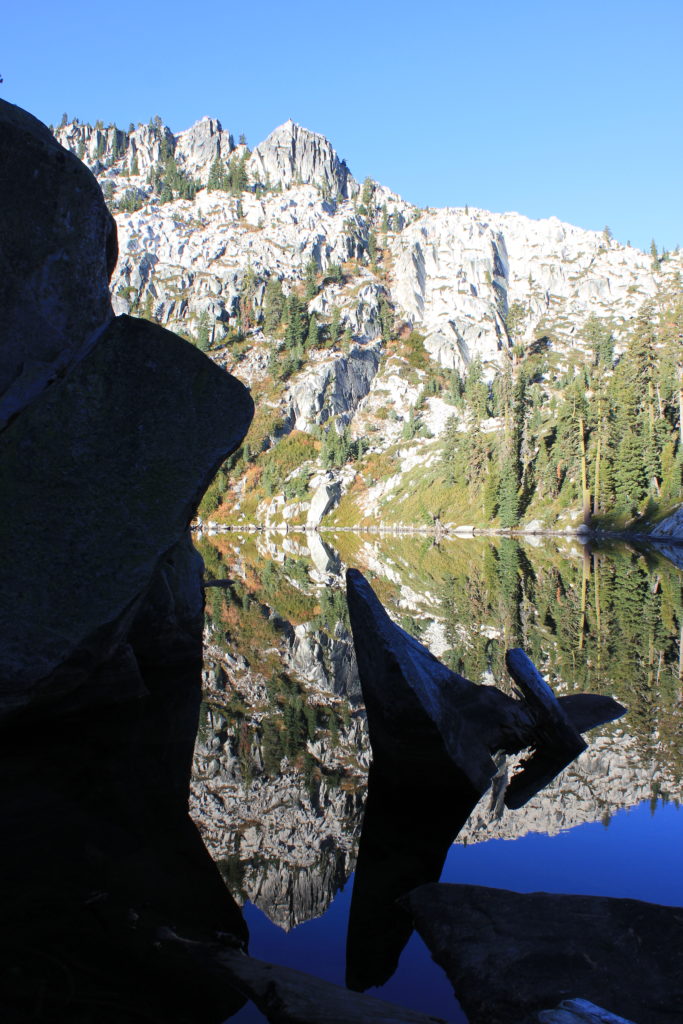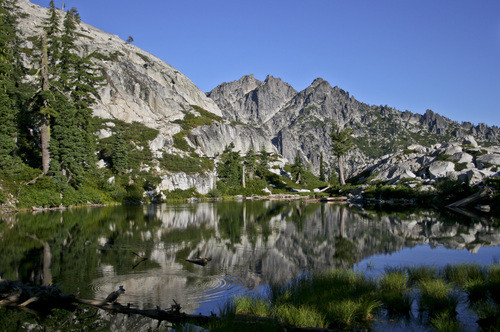“At a certain point you say to the woods, to the sea, to the mountains, the world: Now I am ready. Now I will stop and be wholly attentive. You empty yourself and wait, listening. After a time you hear it: there
is nothing there. There is nothing but those things only, those created objects, discrete, growing or holding, or swaying, being rained on or raining, held, flooding or ebbing, standing or spread. You feel
the world’s word as a tension, a hum, a single chorused note everywhere the same.
This is it: this hum is the silence…”
— Annie Dillard
“Teaching a Stone to Talk”
After lunch, Greg and Suzanne wanted to hang out down by Wee Bear, but I’d spent nearly all the day before trying to paint that scene, and decided instead to pick a shady spot next to the emerald cove with the outlet trickle. I situated myself so I could see all the best parts of the visually stunning Little Bear rim; from Bumblebee Springs across the lake to the south, to the teeming spire of Altamira to the west and up, up into the sapphire sky. The surface of the lake was doing its intricate dance again, where small peaks of water quickly rose up on their toes, pirouetted, then glissaded gracefully, like a million choreographed ballerinas.
Across the lake, underneath a massive, keystone-shaped monolith, Bumblebee Spring flowed from deep within the snow-fed aquifers of the mountain. This icy, pure water filled the basin where it turned green from algae and life. Overflowing to my left in White Bear Cove, it wandered downhill and collected again to form Wee Bear, joining with local surface snow melt. This, too, flowed over the edge of its basin and plunged a thousand feet down the face of the granite cliffs to Bear Creek, where some of it eventually meandered all the way down to the trailhead, past where my car was parked, and into the Trinity River. Ultimately, its journey would end in Eureka far to the west – merging with the Pacific Ocean.
Imagining a winter scene from Swan Lake, I visualized what Little Bear Lake must be like in the dead of winter, frozen into swirls and crests of ice and snow. The little ledges on the rim’s wall would each be topped with a white pillow; softly stepping down to huge drifts of snow all around the lake shore. The stately green pines would be flocked with the snow too, with a chilly mist whirling above and between their branches. The water looked so different then, on the first day of autumn. It seemed so alive and capable of intelligent movement. I could think of no entity but water that was capable of grinding and scouring huge cirques and valleys from the stony guts of mountains over hundreds of thousands of years, just so it had a place to dance.
I wondered: what is this miracle that is capable of such beauty and destruction?
Water molecules were all around me, in lake and sky. H2O, is a unique molecule that can exist as a solid, liquid, and a gas. We have common names for all 3 stages: ice, water, and vapor, but think little of the in-between stages where the rigid molecular structure of the solid is transforming into a liquid, and then shifting its configuration again to be a gas. It seems as if the bonds of the molecules have a tenuous relationship with reality. What other substance does this? In a mountain lake, all three stages play out over four seasons. This most ordinary and yet most remarkable of materials calmly illustrates the perpetual process of birth and rebirth before our eyes every day.
Water is exceptionally slippery. In liquid form, the molecules bond together and break apart in real time. This evokes comparison to the constant recycling of subatomic particles in nanoseconds, or the formation and erosion of mountains over epochs, but on a time scale we can observe and feel. I can submerge my entire body in water, and feel its pulsating power in every cell. In everyday life, water is inescapably intimate, making up over 97% of our bodies. Rain falls and beads on our skin and soaks in, or slides around until the drops bind together and trickle straight down our bodies towards the center of the earth.
In frozen form, water is powerful enough to crack mountains and carve great valleys. And yet it is remarkably delicate, as the intricate and unique images of frost and snowflakes will testify. Water is the only liquid substance that becomes less dense as it is frozen. What’s more, its molecules rearrange themselves into a kind of rigid, crystal scaffolding, expanding forcefully to take up more space. A loose agglutination of liquid water molecules will reassemble into endless varieties of locked physical formations when frozen. Human beings have no answer for the might of frozen water. We are largely impotent before the manifest genius of innovation, form, and power in common ice. Our species is so quick to get rid of that which it cannot understand or control. In an extreme example, some say that we humans are responsible for climate change, which will eventually eliminate all solid ice from the planet.
Water is extremely rare in the universe, and rarer still in liquid form. Even on our luscious blue marble, where the surface is over 70% liquid water, there are places where one could die for lack of it. Less than 2.5% of the water on earth is fresh, and nearly all of that is hidden deep in aquifers, or locked up in ice. Only about 1% of the fresh water is available for us to drink, and we must share every drop. Most of my life I lived in California, where water is so often taken for granted, except by farmers. Elsewhere in the world, there is not such a casual attitude. A rising proportion of the earth’s population has inadequate access to safe drinking water, and wars are fought for its control. Here, we sprinkle it on our lawns and fill our swimming pools to let it evaporate wastefully into the dry air.
Evaporation produces water vapor, which defies gravity. The vapor is lighter than air due to the effect of its molecules separating and rising when heated. In this way water is born, freeing itself entirely from the petrified bonds of the material world as it becomes a child of the wind. Once airborne, the wayward molecules find each other and glom together as they cool and their weight makes them fall down again. We see huge whipped confections of water droplets formed into puffy white clouds that turn gray and heavy, and then the rain falls down on our world and freezes it once again to a standstill in winter. Then the water is fixed and frozen in place once again, as tongues stick to flagpoles.
Trees also help water to defy gravity by coaxing it hundreds of feet into the air through capillary action in their trunks. This is done without any pumping or muscular contraction (which would be really gross to see in a forest anyway). All vascular plants structurally take advantage of water’s special attractive properties. The hydrogen atoms are lonely it seems, and need to form bonds with other hydrogen atoms of other water molecules. They get together and do amazing things! In this way, water uses its affinity for itself to become more than the sum of its parts.
Trees and other plants release water back into the atmosphere through a process called transpiration. This is the term for squeezing the water out to the very tips of its needles or leaves, breaking it apart, and setting it free. The word itself is interesting due to its obvious similarity to inspiration, which can mean both a filling of our lungs and our souls. Given the revolutionary meaning of the prefix trans, what miracles are wrought from trans-piration? In common usage, the word transpire means “to happen.” Are plants just happening to synthesize the water they need to fall from the sky in order to survive? There are far greater biological synergies than we can ever imagine.
Consider that all known forms of life depend on water. All life has awareness, and water is the common denominator and messenger of universal knowledge. Every microscopic particle of every cell in our bodies is dissolved in water. Our cellular components derive their structure and activity from molecular interactions with this most universal solvent. Imagine what facilities our proteins and DNA gain from the same medium that freezes into an infinite variety of snowflakes! A sincere realization of this will lend considerable urgency to your fight against dehydration. It may also cause you to reconsider the quality of the water you drink. If water is bringing us the very structure of life, which comes from God, shouldn’t we vigorously protect the purity of our water above all else?
God, or the Supreme Being, is the origin of all purity, and Mother of the stars. Much of the water that exists in the universe is produced as a byproduct of her birthing of stars, like a sort of interstellar amniotic fluid. The titanic waves of creation surge outward and compress the molecules into water vapor. Huge clouds have been observed in distant galaxies as our optical tools improve over time. So, water is born in the stars, is necessary for all life, makes up nearly all of our bodies, and interacts with the components of our cells at the molecular level. How can we deny that water is the lifeblood of the universe?

“Hey, you know, I was thinking a lot about water today…” I tossed the first log on the fire. Our conversation blazed and burned that night, fed not only by all we had seen both together and separate, but by the ramifications of knowing its significance. Once the mind is stretched to a new idea, it never goes back to its original dimension. What was most compelling was the inter-connectedness of it all. It was like a fantastic symphony of recognition, rising in a brilliant crescendo of gratitude and appreciation between us all.
Eventually our conversation turned to birth and death, which is the cycle to which we are most intimately connected. We would be leaving this beautiful sanctuary tomorrow, and wanted to brand its essence indelibly on our souls. “Thank you for leading me to this place, Dad,” I thought to myself during one of our many pensive pauses. My salute was sincere, and yet I felt inexplicably sad about it. Guilt for the past was our family’s favorite pastime.
Why was I thinking of my father so much during this trip? Where do thoughts come from, anyway? Sometimes they just sneak up on you like a cat, and are sleeping on your lap before you realize it. I believe there is a “field” of universal awareness like an atmosphere, where notions coalesce into droplets of reason, and rain down on our minds. Thoughts are not just a construct of our biological cortex that will cease with its physical demise. Our brain functions more like an antenna, capturing non-physical signals from the cosmos and interpreting them into our biological paradigm. We blossom into language and concepts as we grow up, but what are the roots of our thoughts? Dig deep to consider that Helen Keller was deaf and blind, and had little real communication with other humans until the age of 7 when she met her teacher. What did she think about in her isolated existence, having learned neither language nor human protocol? She stayed in the in-between world of an infant much longer than most. Did she develop her non-linguistic, primal thoughts to be more sophisticated as a result? I always felt like infants and very young children are the closest to God, because they have not yet learned to pollute the clear stream of unconditional love with culturized human thoughts.
As we get older, we learn to think in language and concepts, but how do we perceive our own thoughts before we can relate with others? Each of us must have an innate, inborn understanding of the source of all our thoughts. Anyone who has spent time around an infant who has not yet learned to relate can attest that they have definite intentions, desires, and perceptions. Some say that our thoughts are developed after birth by our brain as it grows and learns how to interact with its environment. Now modern science tells us that the embryo is capable of neurological activity. Indeed, as our instruments to observe and measure get more sophisticated, we have to expand our ability to comprehend – that is the essence of science. Humans always seem to find more and deeper layers to anything they continue to study. What are the primal neurological perceptions of which an embryo (or even a blastocyte) is capable? We are limited in our recognizance only by our lack of data and inability to comprehend.
As soon as a baby learns to communicate, and is culturized into society mores, she isolates in a different way and learns to think of herself as separate from all that is. With the ability to cognize comes the tendency to categorize. This is how we learn to think of ourselves as entities distinct from our surroundings. But part of us still “remembers” that which is beyond memory: the primary perception of being. This is the being that observes our self-learning to think; the same one who watches quietly from the background of our self-awareness all our lives. We often call this awareness our “higher self” or “conscience,” which is an interesting word because its roots con and science mean “with” and “knowing.” But how can this awareness be measured for science to understand? Paradoxically, it is a knowing that cannot be “known,” but it can be understood. It broadcasts to us all our lives beyond our sensory perception; and babies are marvelously tuned in.
What does a baby think of in the womb, before she has had any human contact?
If you told a baby in the darkness of her mother’s womb, “Outside there is a world of light, with trees, high mountains, beautiful lakes, birds, animals, flowers of every kind, a brilliant sun, glowing moon, and a sky full of clouds and stars,” she would not believe you. The unborn child, knowing nothing but the darkness and comfort of her own little world, is unaware that there could be anything more, and is afraid. Even after birth, taking all these marvels for granted, we stay enclosed in our own wombs of darkness, and fear the unknown.
This is why we are terrified of the greatest unknown: death. We begin our lives in darkness, and the shock of being exposed to light most often makes us scream in terror and discomfort. We remember the terror of this transition our entire lives, and so we face death – the next great transition – with great trepidation. But everything in the universe is a cycle made of endless rounds of inspiration and expiration, and nothing ever ceases to exist. Perhaps our expiration leads again to inspiration, and on, and on. Where were we before we were born? Why are we afraid to return from whence we came? If we came from somewhere, surely we must return to it like everything does. The cosmic spark that results from the biological union of egg and sperm is the beginning of a new life, but whence came the spark? How can death be the end of this fire that has no beginning?
In that place where something has no beginning, time is meaningless. And what is time, anyway? We measure time based on the revolution and orbit of our planet around its star, but from the universe’s point of view that is so arbitrary. The universe just is, regardless of our efforts to quantify its existence. What we see is not time, but change. Our lives are measured in terms of these arbitrary “years,” but are really just one present moment after another, which can be differentiated only by change. Who’s to say how long a moment is in terms of time, or how many moments are given? What is essential to existence is change. Obviously, many of us experience more changes than a few others whose lives are shorter by how we measure them in time and space, but the present moment is not dependent on time or space, or on how many moments led up to it. The present moment is timeless. So how can a life, measured in time, be comprised of moments that are immeasurable and timeless? Maybe the moments in our lives should be gauged by the quality of the manifest change they produce, and not by their quantity.
“A human being is a part of the whole called by us the universe; a part limited in time and space. He experiences himself, his thoughts, and feelings as something separated from the rest – a kind of optical delusion of his consciousness. This delusion is a kind of prison for us, restricting us to our personal desires, and to affection for a few persons nearest to us. Our task must be to free ourselves from this prison by widening our circle of compassion to embrace all living creatures, and the whole of Nature in its beauty.”
— Albert Einstein

